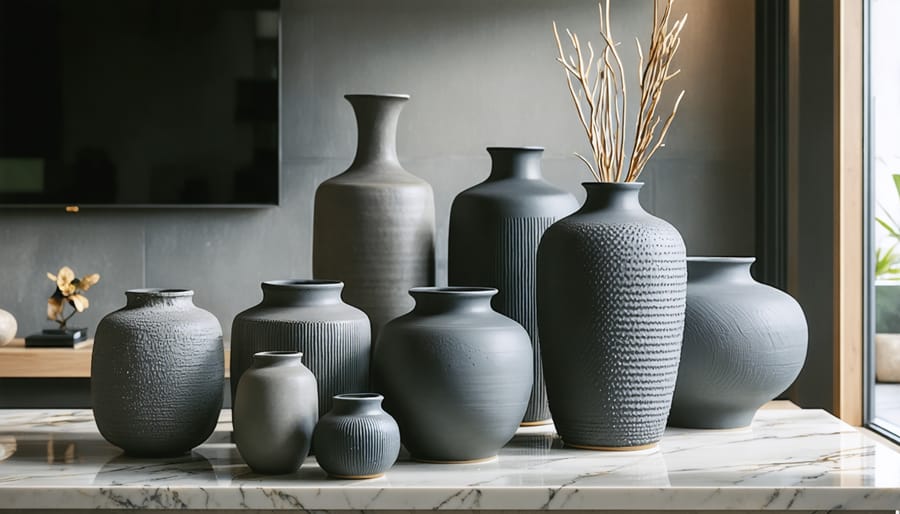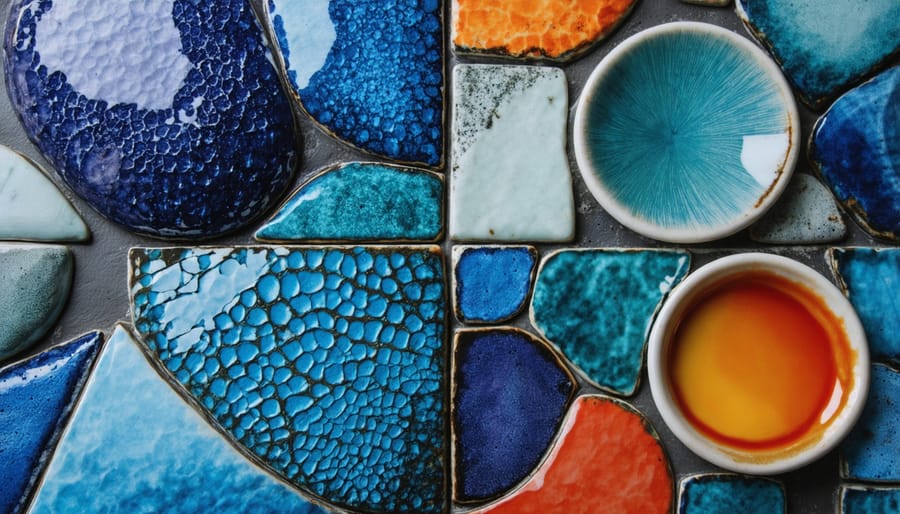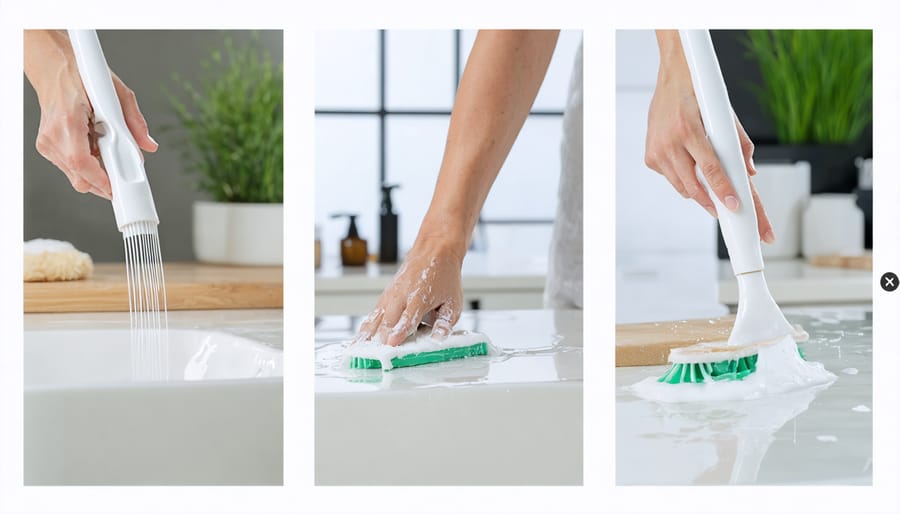Transform your living spaces with ceramic design’s timeless appeal and versatile applications in today’s modern home design elements. From handcrafted tiles to sculptural vessels, ceramics blend artisanal craftsmanship with contemporary aesthetics, creating spaces that feel both sophisticated and welcoming.
The resurgence of ceramic design in interior spaces speaks to our growing appreciation for tactile, organic materials that bring character to our homes. Whether it’s a statement wall of artisanal tiles, a collection of minimalist pottery, or architectural ceramic installations, these elements add depth, texture, and visual interest while remaining remarkably practical.
Today’s ceramic designers push boundaries by combining traditional techniques with innovative glazes, patterns, and forms. This fusion of old and new creates pieces that honor ceramic’s rich heritage while meeting contemporary design demands. From matte finishes that complement industrial aesthetics to high-gloss surfaces that reflect light in unexpected ways, modern ceramics offer endless possibilities for personalizing your space.
For homeowners seeking to incorporate this versatile medium, ceramic design provides an accessible entry point into custom interior decoration, offering durability and beauty that withstand changing trends and daily use.
The Evolution of Ceramic Design in Modern Spaces
Contemporary Ceramic Styles
Today’s ceramic design landscape celebrates a fascinating blend of tradition and innovation, with styles that range from minimalist to boldly expressive. Clean lines and organic shapes dominate modern collections, often featuring matte finishes and subdued earth tones that complement contemporary interiors. Many designers are incorporating contemporary artistic elements through unexpected textures and geometric patterns.
Wabi-sabi inspired pieces, which embrace natural imperfections, have gained significant popularity among design enthusiasts. These pieces often feature irregular forms, subtle glazes, and handcrafted details that add character to living spaces. Meanwhile, the emergence of modern rustic styles combines traditional pottery techniques with updated forms, creating pieces that feel both timeless and fresh.
Color trends in contemporary ceramics lean towards neutral palettes punctuated by bold accents, with speckled glazes and color-blocking techniques adding visual interest. Functional pieces often double as decorative objects, reflecting a growing appreciation for both beauty and utility in home design. This versatility makes modern ceramics particularly appealing for those seeking to add personality to their living spaces while maintaining a sophisticated aesthetic.

Material Innovations
Today’s ceramic technology has evolved far beyond traditional glazed tiles and pottery. Manufacturers are now producing ceramics that mimic natural materials with incredible accuracy, from wood-grain textures to marble-like finishes. These innovations make it possible to enjoy the look of luxury materials while benefiting from ceramic’s durability and easy maintenance.
One of the most exciting developments is the introduction of large-format ceramic slabs, which can span entire walls or floors with minimal grout lines. Digital printing technology allows for intricate patterns and designs that were previously impossible to achieve, opening up endless creative possibilities for home design.
New surface treatments are also transforming the way we use ceramics. Anti-slip finishes make them safer for bathrooms and outdoor spaces, while antibacterial glazes are perfect for kitchens and high-traffic areas. Eco-friendly ceramics made from recycled materials are gaining popularity, offering sustainable options without compromising on style or quality.
Smart ceramics with built-in heating elements or light-responsive properties are emerging as game-changers in modern interior design, proving that this ancient material continues to evolve with our changing needs.
Incorporating Ceramic Elements in Your Home
Statement Pieces vs. Subtle Accents
When it comes to incorporating ceramics into your home, you’ll need to decide whether to make a bold statement or create subtle layers of interest. Large-scale ceramic pieces, much like statement art pieces, can become the focal point of a room. Consider placing an oversized ceramic vase in your entryway or a dramatic wall installation in your living room to immediately draw the eye and set the tone for your space.
For subtle accents, small ceramic pieces work beautifully when grouped together. Try arranging three different-sized vessels on a coffee table, or display a collection of miniature ceramic bowls on open shelving. The key is to create balance – if you opt for a bold statement piece, keep surrounding decorative elements minimal and complementary.
When choosing between statement and subtle pieces, consider your room’s size and existing decor. Large, open spaces can handle dramatic ceramic installations, while smaller rooms might benefit from thoughtfully placed accent pieces. Don’t be afraid to mix both approaches – a striking ceramic sculpture can coexist beautifully with delicate ceramic details scattered throughout the space.
Remember that color plays a crucial role in impact. Bold, vibrant glazes naturally draw attention, while neutral tones and natural finishes offer a more understated presence. Choose pieces that complement your overall design scheme while achieving your desired level of visual interest.
Color and Texture Combinations
Blending ceramic pieces with your existing décor is all about creating harmonious combinations that enhance your space. Start by identifying your room’s color palette and dominant textures. Matte ceramics work beautifully in spaces with lots of glossy surfaces, creating a pleasing contrast, while glazed pieces can add sparkle to rooms with predominantly soft textures.
For modern interiors, consider combining sleek white ceramics with natural wood elements or metallic accents. The contrast between smooth, polished surfaces and organic textures creates visual interest without overwhelming the space. Earth-toned ceramics, like terracotta or sage green, pair wonderfully with neutral furnishings and can add warmth to minimalist settings.
When mixing patterns, follow the 60-30-10 rule: use solid-colored ceramics for 60% of your pieces, textured items for 30%, and bold patterns for the remaining 10%. This balance ensures your ceramic elements enhance rather than compete with your existing décor.
Don’t be afraid to experiment with unexpected combinations. A rustic, handmade ceramic vase can become a striking focal point in a contemporary room, while geometric ceramic tiles can add modern flair to traditional spaces. Remember that lighting plays a crucial role – position your ceramics where natural light can highlight their unique textures and glazes for maximum impact.

Room-by-Room Applications
Each room in your home offers unique opportunities to showcase ceramic design elements. In the kitchen, consider incorporating handmade ceramic tiles for a striking backsplash or installing decorative ceramic plates as wall art. Contemporary ceramic pendant lights above kitchen islands create a stunning focal point while maintaining functionality.
Bathrooms are perfect for ceramic experimentation. Beyond traditional floor tiles, try adding ceramic accent walls, decorative soap dishes, or even artistic vessel sinks. Modern geometric patterns can transform a simple powder room into a designer space.
In living areas, ceramic vases, sculptures, and decorative bowls can serve as conversation-starting centerpieces. Large-format ceramic tiles on feature walls create dramatic visual impact, while ceramic side tables offer both style and durability.
For bedrooms, ceramic table lamps provide elegant lighting solutions, while decorative ceramic wall tiles can create stunning headboard alternatives. Consider incorporating small ceramic trinket dishes on nightstands for both functionality and style.
Outdoor spaces benefit from weather-resistant ceramic pieces too. Garden stools, planters, and wall tiles can withstand the elements while adding artistic flair to your exterior design. For covered patios, ceramic wall installations or fountains create sophisticated outdoor living spaces that seamlessly connect with your interior design scheme.
Remember to maintain consistency in your ceramic choices throughout connected spaces, using complementary colors and patterns to create a cohesive flow between rooms.
Maintenance and Care

Cleaning Techniques
Keeping your ceramic pieces looking their best requires the right cleaning approach for each finish type. For glazed ceramics, a gentle solution of warm water and mild dish soap works wonders – simply wipe with a soft cloth and dry thoroughly to prevent water spots. Avoid abrasive cleaners that might scratch the surface.
For unglazed ceramics, start with a dry brush to remove loose dirt, then use a slightly damp cloth with mild soap if needed. These pieces are more porous, so it’s crucial to avoid soaking them. For stubborn stains on either type, create a paste using baking soda and water, apply gently, and rinse thoroughly.
Textured or relief ceramics require special attention – use a soft brush to clean between patterns and crevices. For delicate hand-painted designs, avoid harsh chemicals and stick to light dusting or gentle wiping with a barely damp cloth.
Remember to always test cleaning solutions on a small, inconspicuous area first, and never use bleach or acidic cleaners on any ceramic surface. Regular dusting can prevent the need for deep cleaning and help maintain your pieces’ beauty longer.
Preservation Tips
To keep your ceramic pieces looking beautiful for years to come, proper care and maintenance are essential. Start by dusting your ceramics regularly with a soft, dry cloth to prevent dirt buildup. For deeper cleaning, use mild soap and warm water, avoiding harsh chemicals that can damage the glaze. Always hand wash your pieces rather than putting them in the dishwasher, even if they’re labeled dishwasher-safe.
Store your ceramics in a stable environment away from direct sunlight and extreme temperature changes, which can cause cracking or fading. When displaying multiple pieces, use felt pads or rubber bumpers to prevent them from touching each other. For valuable or antique ceramics, consider using museum gel to secure them in place, especially in earthquake-prone areas.
If you notice any chips or cracks, address them promptly to prevent further damage. Small repairs can often be done at home using food-safe epoxy, but for significant damage or valuable pieces, consult a professional ceramic restorer. Keep records of any repairs and maintain a consistent cleaning schedule to ensure your ceramic designs remain stunning focal points in your home for generations.
Selecting Quality Ceramic Pieces
Quality Indicators
When evaluating ceramic pieces, several key indicators reveal the quality of artisanal craftsmanship and overall design excellence. Start by examining the piece’s weight and balance – high-quality ceramics typically feel substantial and sit steadily without wobbling. Run your fingers along the surface; well-crafted pieces should have a smooth, consistent texture free from unwanted bumps or rough patches.
Look closely at the glaze application – it should be even and free from bubbles, crawling, or bare spots. Quality glazing creates depth and character while maintaining uniformity in its finish. The bottom of the piece, known as the foot ring, should be properly trimmed and smooth, with no sharp edges or excess clay.
For functional pieces, check that lids fit securely, spouts pour cleanly, and handles feel comfortable and sturdy. Pay attention to the joints and seams – they should be nearly invisible on well-made ceramics. Color consistency is another crucial factor; variations should appear intentional rather than accidental.
Finally, examine the piece in good lighting to spot any hairline cracks, chips, or firing flaws. Remember that some natural variations are characteristic of handmade ceramics and often add to their charm, but structural imperfections should raise red flags.
Investment Considerations
When investing in ceramic pieces, quality should be your primary consideration. Look for items with even glazing, consistent coloring, and no visible cracks or chips. Run your fingers along the surface to check for smoothness and examine the bottom for any rough spots that might scratch your surfaces.
Consider the piece’s functionality alongside its aesthetic appeal. For everyday items like plates and bowls, ensure they’re dishwasher and microwave safe. For decorative pieces, think about their placement and how they’ll interact with your existing décor.
Size and scale matter significantly in ceramic design. Before purchasing, measure your space and consider how the piece will fit within it. Remember that larger statement pieces can command attention but require more prominent display areas, while smaller items can be grouped for impact.
The artist’s reputation and craftsmanship should factor into your decision. Research the maker or brand, looking for reviews and previous work. While handmade pieces might carry a higher price tag, they often offer unique character and better quality than mass-produced alternatives.
Finally, consider the maintenance requirements. Some ceramics need special care or regular cleaning, while others are more durable. Factor in your lifestyle and how much time you’re willing to dedicate to maintaining your ceramic investments.
Ceramic design represents far more than just functional pottery or traditional tiles – it’s an art form that continues to evolve and shape modern interiors. Throughout this exploration of ceramic design, we’ve discovered how versatile and transformative these elements can be in creating spaces that are both beautiful and practical.
From selecting the perfect ceramic pieces for your home to understanding glazing techniques and maintenance requirements, you now have the knowledge to make informed decisions about incorporating ceramics into your living spaces. Remember that ceramic design offers endless possibilities, whether you’re drawn to minimalist vases, statement wall tiles, or artistic tableware.
Don’t be afraid to experiment with different textures, colors, and patterns. Start small with decorative pieces before moving on to larger installations. Mix contemporary designs with traditional elements to create a unique style that reflects your personality. Consider the practical aspects we’ve discussed, like durability and maintenance, but let your creativity guide your choices.
As you begin your ceramic design journey, keep sustainability in mind. Ceramics are not only environmentally friendly but also timeless, making them a smart investment for your home. Whether you’re renovating your kitchen, updating your bathroom, or simply looking to add character to your living space, ceramic elements can provide that perfect blend of functionality and artistic expression.
Take the first step today in transforming your space with ceramic design. Your home deserves pieces that tell a story and stand the test of time.
